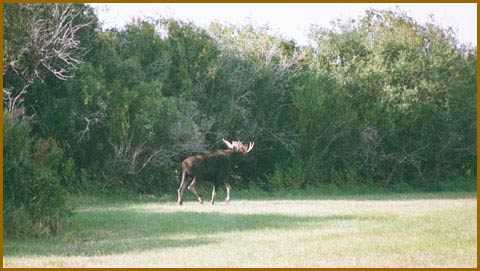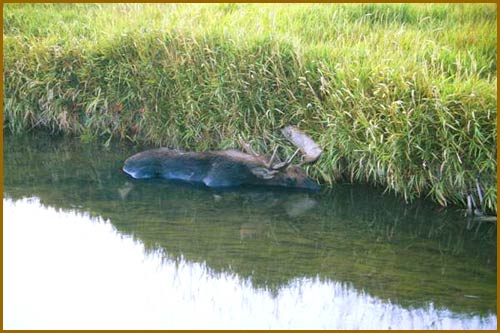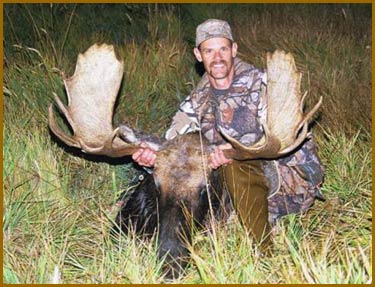Bowsite.com
The Nation's Leading Bowhunting Website
I was just preparing to depart the southwestern Wyoming ranch and head to another hunting area, when I looked down the creek bottom and happened to see two cow moose feeding on some willow bushes. The rancher told me earlier that some fishermen had seen two cows and a bull that morning so I decided to have a closer look. Heading down to the creek, I saw one of the cows bed in the waste-high grass - the other cow continued to feed on the willows. After stalking to within about 30 yards of her, I stopped behind some willows and watched her feed. She was reaching up and ripping the leaves off of the top of the bushes, making quite a racket in the process. Enjoying watching her, I started wondering if the bull was still with the cows. Then I glanced to my right and about fell over! There he was bedded below some willow bushes only 50 yards away on the edge of a cut hayfield. From his viewpoint, I was standing in the open and thought surely he had seen me. But a second look revealed he was bedded facing away from me. I slowly pulled out my binoculars to take a closer look. His body was huge – he looked like a Brahma bull. Looking down at my diminutive Mathews MQ-1 bow, I hoped it would do the job given the opportunity. The bull had some nice long tines, good paddles, and looked fairly wide - he was definitely a shooter. I mentally picked a spot in the willows about 20 yards from him where I wanted to stalk to.
I slowly backed up keeping an eye on both the bull and the cow. If the cow spooked she would probably take the bull with her. I was relieved when I had gotten some willows between the two moose and me. Then I very slowly stalked along the edge of the willows towards where the bull was bedded. Stopping at my predetermined location, I quietly knelt between two willow bushes out of sight of the bull. I nocked an arrow, attached my release to the bowstring, and began waiting. My plan was relatively simple and nearly foolproof, I thought. Since I was set up between the two cows and the bull, I expected the bull to eventually get up and walk across the small cut hayfield toward the cows offering me a nice, close broadside shot. Now I just needed to be patient and hope the wind would cooperate. Drawing a License Planning for my 2000 Wyoming Shiras moose hunt actually began about six years prior to my hunt taking place - that is when I first started applying for a license. Drawing a license can be one of the hardest parts of harvesting a Shiras moose. Due to the relatively low populations of moose compared to deer and elk, licenses are only available through a computer drawing and the odds of drawing are very low. To maximize my odds, I started applying for a license in Wyoming. Wyoming offers several advantages for drawing a moose license over other western states. For example, the state has the highest Shiras moose population in the country, approximately 15,000 animals, and offers the highest number of licenses - as many as 1,800 annually. But more importantly, beginning in 1994 Wyoming went to a preference point system for moose which greatly increased the odds of drawing a license in a reasonable amount of time. The preference point system works by awarding you a preference point for each year that you apply but are unsuccessful in the drawing. Preference in the drawing is then given to the applicants with the highest number of points. And unlike Colorado, which also uses a preference point system, preference points in Wyoming continue to accumulate until the hunter draws a license. In Colorado, you can only accumulate a maximum of three preference points. Wyoming allocates 75% of the moose licenses through the preference point system - 25% of the licenses are allocated on a pure lottery basis independent of the number of preference points you have. So you still have a small chance of drawing even if you don’t have any preference points. Beginning back in 2000, Wyoming also made it financially easier to accumulate preference points. Now you only need to submit a $7 fee to obtain a preference point instead of submitting the full $1,010 nonresident license fee. However, you aren’t actually put in the drawing unless you submit the full amount. A good way to use the system to your advantage is to buy preference points at $7 each for several years until you have enough points to draw a license, and then submit the full amount. As a demonstration of the effectiveness of the preference point system, I contacted Harry Harju, who is the Assistant Chief with the Wyoming Game and Fish Department, to find out how long it might take a new applicant starting with no preference points to draw a license. Harry estimated that a new applicant would have a good chance of drawing a bull moose license in 3 years and in the worst case, would draw in 8 years. This is in stark contrast to the number of years that may have been required to draw when Wyoming was on the pure lottery system. One hunter I knew had applied for more than 25 years without drawing a license and may never have drawn if the preference point system was not implemented. Moose licenses in Wyoming are rifle licenses – there are no separate archery licenses. However, once you draw the rifle license you can buy an archery tag that enables you to hunt an earlier archery season in addition to the regular rifle season. Seasons vary somewhat, but in the unit I hunted the archery season went from September 1 though 30 and the rifle season went from October 1 through 31 so I had a full two months to choose from. Archery hunting is allowed during rifle season and according to Harry, bowhunting during this season can be very productive because it coincides with the rut. So by using the preference point system to my advantage, I drew a 2000 bull moose license. Although I was excited about drawing the license, it really wasn’t a surprise. Statistics from the previous year showed that the odds of drawing a nonresident license in my unit were 100% for applicants with the maximum number of preference points. That’s one of the beauties of the preference point system, you can actually predict when you are going to draw a license.
The Hunt During the first couple of days of the hunt I covered a lot of ground and saw several moose including two decent bulls. It was early in the hunt so I kept searching, hoping to find a bigger bull. Early afternoon of the third day, I stopped by a rancher’s house where I had earlier obtained permission to hunt. The rancher was having what he called “moose problems.” Apparently he had some bulls that were tearing up fences and trees and getting into the haystacks. One bull in particular started rutting early, had chased some of the livestock off, and was generally acting aggressive. The rancher said I would be doing him a favor if I shot this bull, as he was worried he might hurt someone. I would do my best to oblige. Not intending to hunt the ranch that day, I just checked in to see if the rancher had seen any good bulls recently. Apparently the moose came and went on his property. He had good news - an older couple fishing the creek that morning ran into two cows and a bull. The bull stood his ground and, unfortunately for the couple, ended their fishing for the day. So I decided to still hunt up the creek bottom and call to see if I could locate the bull. I didn’t expect much as it was mid afternoon and very hot - not prime hunting conditions, especially for a heavy-coated bull moose. As expected, I didn’t see or hear anything and was just getting ready to leave. That’s when I saw the two cow moose feeding on the willows further downstream. After spotting the bedded bull, stalking to within 20 yards of him, and kneeling in the willows, I waited. And waited. And waited. For three and a half hours. I thought about stalking around the willows and trying to shoot the bull in his bed or throwing a rock to get him to stand up. But from my experience stalking and spotting mule deer, it is usually best to let an animal get up on their own to offer an easy, unhurried shot. When I first arrived at my hide in the willows, I was excited with anticipation and expected the bull to get up at any minute. After the long wait, I was actually starting to doze off. That is until just before dusk when the bull grunted - he must have stood up. Slowly poking my head around the willow bush, I saw a big black nose sticking out from the willows about 15 yards away. The bull was standing and looking to my left in the direction of the bedded cows. My heart began racing in anticipation of getting a shot. I expected him to walk into the cut hayfield toward the cows and offer me a nice 25 to 30 yard broadside shot. All I would need to do is draw my bow and do a grunt with my voice to stop him for the shot. I had earlier used my laser range finder to shoot the distance to a couple clumps of grass where I expected the bull to walk. But for some unknown reason, instead of walking to my left toward the cows, the bull started slowly walking along the edge of the willows directly at me. “Oh no!” I said to myself and tried to make myself as small and inconspicuous as possible. The bull kept coming until he was about 3 yards away! Then he stopped broadside, looming over me. To say I was concerned and excited is an understatement. But surprisingly I was more concerned about spooking him and not getting a shot than the potential danger of a rutting bull moose being that close. I was used to hunting deer and elk, animals that run away when they know of your presence. My head was buried under my bow and I was using my peripheral vision to watch him. He was looking to my left and periodically grunting - good he hadn’t seen me yet. Then out of the corner of my eye, I saw his head and big rack turn and look directly at me. He stared at me for a few seconds, then put his head down, and actually started walking closer! I got the feeling the bull thought I was some insignificant creature such as a porcupine and just wanted to check me out. At about 2 yards, I decided he was close enough and it was time to make a move. Coming up on my knees I drew my bow, almost in self-defense. Not wanting to take a head-on shot, I held at full draw. I really assumed that when I drew he would spook. But apparently moose don’t behave like deer and elk. Instead he just stopped, put his ears back, and glared at me – a sure sign of aggression. Time stopped. I didn’t dare breath. After what seemed like hours, he must have decided he had enough of this foul-smelling creature, nonchalantly turned to his right, and started slowly walking away. As he turned broadside a few steps away, I swung my 20-yard pin behind his shoulder and triggered the release. The arrow disappeared into his chest – a complete pass-through. The bull only went about 60 yards and piled up in the middle of the creek. After my heart rate returned to normal, I admired the bull and then went to get some help. Now the work would begin but that’s another story.
|








